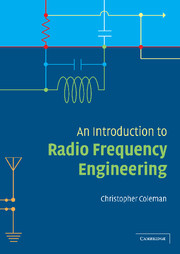Book contents
- Frontmatter
- Contents
- List of figures
- Preface
- Acknowledgements
- 1 Basic concepts
- 2 Frequency selective circuits and matching
- 3 Active devices and amplifiers
- 4 Mixers, modulators and demodulators
- 5 Oscillators and phase locked loops
- 6 Transmission lines and scattering matrices
- 7 Power amplifiers
- 8 Filters
- 9 Electromagnetic waves
- 10 Antennas
- 11 Propagation
- 12 Digital techniques in radio
- Index
4 - Mixers, modulators and demodulators
Published online by Cambridge University Press: 05 June 2012
- Frontmatter
- Contents
- List of figures
- Preface
- Acknowledgements
- 1 Basic concepts
- 2 Frequency selective circuits and matching
- 3 Active devices and amplifiers
- 4 Mixers, modulators and demodulators
- 5 Oscillators and phase locked loops
- 6 Transmission lines and scattering matrices
- 7 Power amplifiers
- 8 Filters
- 9 Electromagnetic waves
- 10 Antennas
- 11 Propagation
- 12 Digital techniques in radio
- Index
Summary
Semiconductor devices will always have some form of non-linearity in their characteristics and this can be both an advantage and a disadvantage. For amplifiers, non-linearity is clearly a disadvantage in that the amplified signal will not be a faithful reproduction of the input signal. Mixers, however, provide an example of the advantages of non-linear behaviour in semiconductor devices. An ideal mixer is a device for which the output is the product of two input signals. For purely sinusoidal inputs, this will imply outputs at the sum and difference frequencies. Mixers are essential for operations such as frequency translation, modulation and detection. As a consequence, they are an important building block for both transmitters and receivers. The current chapter considers the operation of a variety of mixers and their application to modulation and demodulation. In addition, the chapter considers some modulation and demodulation processes that do not involve mixing.
Diode mixers
Diode mixers are important because of their low noise characteristics. Whilst single diode mixers are not normally used at frequencies below 1 GHz, their analysis provides some useful insight into the operation of mixers in general. It should be noted that diode capacitance can have a detrimental effect upon mixer performance and low capacitance devices, such as the Schottky barrier diode, will normally be required for operation at higher frequencies.
The circuit in Figure 4.1 shows a single diode mixer that converts an RF input signal at frequency ωRF into an intermediate frequency (IF) signal at frequency ωIF = |ωRF − ωLO| by mixing it with a local oscillator (LO) signal at frequency ωLO.
- Type
- Chapter
- Information
- An Introduction to Radio Frequency Engineering , pp. 86 - 107Publisher: Cambridge University PressPrint publication year: 2004



